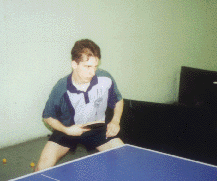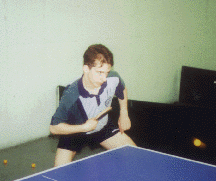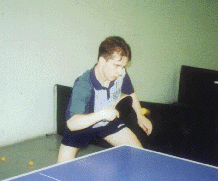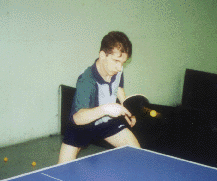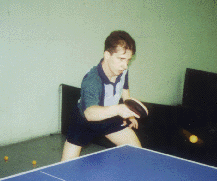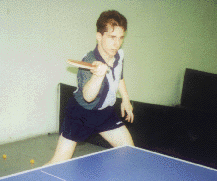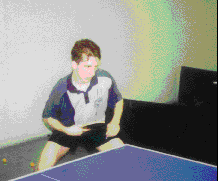|
|
||||||||||||||||||
|
|
||||||||||||||||||
|
|
BACKHAND SMASHby Larry Hodges Because the body is in the way of the backswing, most people find the backhand smash a bit more difficult to learn than the forehand. However, against certain shots, it is actually easier. For example, it can be awkward forehand smashing a short ball; this is the easiest ball to smash on the backhand. Many players develop a powerful forehand and a consistent and/or quick backhand. Not having a good backhand smash is a major weakness with this type of game. Anytime an opponent gets in trouble, he knows what to do—play to the backhand. Even a very fast player will not be able to use their forehand on all of these shots. So how can we make the backhand smash a weapon in our game? Three things:
We will discuss these three things in reverse order. To develop a good backhand smash, you must use it in order to develop it. Using a shot in practice is not the same as using it in a game situation, where you don't know when it's going to come, and where there is the pressure of trying to win the point. This is a basic concept that is true for all techniques, but it particularly applies to this shot. This is because many players are afraid of backhand smashing, finding it an erratic shot. This, of course, is because the shot is not yet developed. If you have good technique and practice it, the shot will start to hit if you keep using it in game situations. It's just a matter of time. However, before you use it in a game situation, you need to practice the shot. Newgy robots are perfect for this. When starting out, set the robot for topspin, somewhat high, to the backhand side. Set the speed so the ball lands in the middle of the table. At first, practice the shot crosscourt. When this becomes comfortable, try smashing down the line until that too is consistent. Finally, try alternating, smashing side to side. This forces you to make the adjustments between two slightly different shots—good practice for using them in a game situation. As you improve, try setting the robot on different settings. You can vary the trajectory, speed and frequency of the incoming ball, and perhaps try it against backspin. (You'll have to open your racket and stroke slightly upward for this last.) When you feel comfortable hitting against all these variations, you will be well on your way toward having a good backhand smash in a game situation. Before you can really practice the shot, however, you need to develop good technique. You can learn this from a coach, from watching top players... or perhaps from the following write-up & photo sequence! What follows is a sequence of Sean Lonergan, 1998 U.S. Collegiate Men's Singles & Doubles Champion. He is practicing on a Newgy robot, set on topspin. (Editor's Note: There are 7 GIF files that Larry has included with this article. The first six are still pictures, and are great for studying the details of each phase of the stroke. The last picture is an animated GIF made from the 6 previous files. This file takes a while to load, but once loaded it will "play" all 6 still pictures in sequence, giving motion to the pictures and providing the viewer with a good idea of the "feel" of the motion and how one phase of the stroke leads into the next phase.) Photo 1: Start of Backswing Sean is in a backhand ready position, intently watching the ball. Elbow is relaxed and near his side. By keeping his knees bent and legs somewhat spread (knees pointing slightly outward), he is able to stay low throughout the stroke. His wrist is already bent backward, bringing his racket toward his chest. Sean plays his backhand with his right leg slightly back, which is a conventional forehand stance. This is partly because he is hitting crosscourt, and relative to that direction, his feet are actually square to the direction he is hitting. However, by staying in a near-forehand stance, Sean is ready to cover most of the table with his forehand. Since the backhand gets its power from the wrist and arm (unlike the forehand, where the body is used more), Sean does not need to stand in a conventional backhand stance to backhand smash, i.e. with left leg slightly back, or feet square to table. Photo 2: End of Backswing Sean is 5'11", yet, because he is staying low, his racket naturally comes toward his chest, instead of toward his stomach as many players (mostly lower ranked) do. His racket is brought back nearly all the way to his chest. He has pulled his elbow out slightly to the side. He has twisted his waist to his left so as to face the ball and to allow himself more room to backswing. Racket is very closed at this point. Photo 3: Start of Forward Swing Sean has opened his racket slightly so that the racket is pointing only slightly down. This will allow him to snap the racket into the ball by snapping his wrist (closing the racket in the process). As Sean strokes forward, his chest pulls back slightly. Sean still has the ball directly in front of his eyes. Photo 4: Contact Sean's racket has begun to close as he contacts the ball. This gives the shot extra snap. Only Sean's arm (including wrist & racket) is moving—power comes from the arm rotating on the elbow and from the wrist. Contact is nearly straight on, with ball sinking directly into the sponge and into the wood. There is a loud crack of the bat at contact. Sean has stayed balanced throughout the stroke. Many players are off-balance when hitting a backhand smash, especially at contact. Photo 5-6: Follow-through Sean's arm and wrist follow through naturally forward. The racket's tip has stayed down throughout the stroke. At the end, Sean's racket whips to the side as his arm and wrist complete the swing. The racket has flipped over like a pancake, finishing with backhand surface pointing straight downward.
Courtesy of Newgy Industries Copyright © 1997 Newgy Industries. All rights reserved. |
|||||||||||||||||
|
Last Update : 06 November, 2002 Copyright © 2001-2006 Ertan Patir Webmaster : Ertan Patir |
||||||||||||||||||

